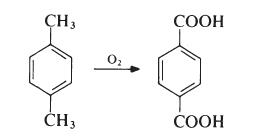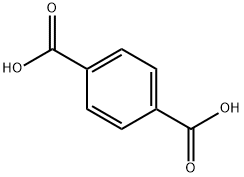테레프탈산
|
|
테레프탈산 속성
- 녹는점
- >300 °C (lit.)
- 끓는 점
- 214.32°C (rough estimate)
- 밀도
- 1.58 g/cm3 at 25 °C
- 증기압
- <0.01 mm Hg ( 20 °C)
- 굴절률
- 1.5100 (estimate)
- 인화점
- 260°C
- 저장 조건
- Sealed in dry,Room Temperature
- 용해도
- 15mg/l(실험적)
- 물리적 상태
- 결정성 분말
- 산도 계수 (pKa)
- 3.51(at 25℃)
- 색상
- 하얀색
- 수소이온지수(pH)
- 3.36(1 mM solution);2.79(10 mM solution);2.26(100 mM solution)
- 수용성
- 물에 약간 용해됨(25°C에서 0,017g/L)
- Merck
- 14,9162
- BRN
- 1909333
- 노출 한도
- ACGIH: TWA 10 mg/m3
- Dielectric constant
- 1.5(Ambient)
- 안정성
- 안정적인. 타기 쉬운. 강한 산화제와 호환되지 않습니다.
- LogP
- 2 at 25℃
- CAS 데이터베이스
- 100-21-0(CAS DataBase Reference)
안전
- 위험 및 안전 성명
- 위험 및 사전주의 사항 (GHS)
| 위험품 표기 | Xi | ||
|---|---|---|---|
| 위험 카페고리 넘버 | 36/37/38 | ||
| 안전지침서 | 26-36 | ||
| WGK 독일 | 3 | ||
| RTECS 번호 | WZ0875000 | ||
| 자연 발화 온도 | 925 °F | ||
| TSCA | Yes | ||
| HS 번호 | 2917 36 00 | ||
| 유해 물질 데이터 | 100-21-0(Hazardous Substances Data) | ||
| 독성 | LD50 orally in Rabbit: > 6400 mg/kg | ||
| 기존화학 물질 | KE-02190 |
테레프탈산 C화학적 특성, 용도, 생산
개요
Terephthalic acid is the organic compound with formula C6H4(COOH)2. This colourless solid is a commodity chemical, used principally as a precursor to the polyester PET, used to make clothing and plastic bottles. Several million tones are produced annually. It is one of three isomeric phthalic acids.화학적 성질
Terephthalic acid is a white crystalline solid. Soluble in alkaline solution, slightly soluble in hot ethanol, insoluble in water, ether, glacial acetic acid and chloroform, consequently up until around 1970 most crude terephthalic acid was converted to the dimethyl ester for purification. It sublimates when heated.역사
Terephthalic acid came to prominence through the work of Winfield and Dickson in Britain around 1940. Earlier work by Carothers and coworkers in the United States established the feasibility of producing high molecular weight linear polyesters by reacting diacids with diols, but they used aliphatic diacids and diols. These made polyesters which were unsuitable to be spun into fibers. Winfield and Dickson found that symmetrical aromatic diacids yield high-melting, crystalline, and fiberforming materials; poly(ethylene terephthalate) (PET) has since become the largest volume synthetic fiber.용도
Terephthalic acid (TPA) is a benzenepolycarboxylic acid with potential anti-hemorrhagic properties. It is a high-tonnage chemical, widely used in the production of synthetic materials, notably polyester fibers (poly-(ethylene terephthalate)).주요 응용
1,4-benzenedicarboxylic acid is mainly used for the production of poly (ethylene terephthalate). Also production of plasticizer dioctyl phthalate (DOTP) and polyester plasticized agents. 1,4-benzenedicarboxylic acid and polyhydric alcohols have a condensation reaction withd iethylene glycol, triethylene glycol, glycerol, propylene glycol, butylene glycol, etc. preparation of the polyester plasticizer.제조 방법
The major commercial route to terephthalic acid which is suitable for the direct preparation of poly(ethylene terephthalate) is from p-xylene:
p-Xylene is obtained largely from petroleum sources, being a product of the fractionation of reformed naphthas. The oxidation is carried out in the liquid phase. Typically, air is passed into a solution of p-xylene in acetic acid at about 200?? and 2 MPa (20 atmospheres) in the presence of a catalyst system containing cobalt and manganese salts and a source of bromide ions. The terephthalic acid produced contains only small amounts of impurities (mainly p-carboxybenzaldehyde), which are readily removed. The acid is dissolved in water at about 2500 e and 5 MPa (50 atmospheres) and treated with hydrogen (which converts the aldehyde to p-toluic acid). The solution is then cooled to 100?? and pure terephthalic acid crystallizes.
주요 응용
Virtually the entire world's supply of terephthalic acid and dimethyl terephthalate are consumed as precursors to polyethylene terephthalate (PET). World production in 1970 was around 1.75 million tones. By 2006, global purified terephthalic acid (PTA) demand had exceeded 30 million tonnes.There is a smaller, but nevertheless significant, demand for terephthalic acid in the production of poly butylene terephthalate and several other engineering polymers.
생산 방법
Terephthalic acid is produced by oxidation of p-xylene by oxygen in air:This reaction proceeds through a p-toluic acid intermediate which is then oxidized to terephthalic acid. In p-toluic acid, deactivation of the methyl by the electron withdrawing carboxylic acid group makes the methyl one tenth as reactive as xylene itself, making the second oxidation significantly more difficult . The commercial process utilizes acetic acid as solvent and a catalyst composed of cobalt and manganese salts, with a bromide promoter.
정의
ChEBI: Terephthalic acid is a benzenedicarboxylic acid carrying carboxy groups at positions 1 and 4. One of three possible isomers of benzenedicarboxylic acid, the others being phthalic and isophthalic acids. It is a conjugate acid of a terephthalate(1-).일반 설명
White powder.공기와 물의 반응
Insoluble in water.반응 프로필
Terephthalic acid is a carboxylic acid. Terephthalic acid donates hydrogen ions if a base is present to accept them. This "neutralization" generates substantial amounts of heat and produces water plus a salt. Insoluble in water but even "insoluble" carboxylic acids may absorb enough water from the air and dissolve sufficiently in Terephthalic acid to corrode or dissolve iron, steel, and aluminum parts and containers. May react with cyanide salts to generate gaseous hydrogen cyanide. Will react with solutions of cyanides to cause the release of gaseous hydrogen cyanide. Flammable and/or toxic gases and heat are generated by reaction with diazo compounds, dithiocarbamates, isocyanates, mercaptans, nitrides, and sulfides. React with sulfites, nitrites, thiosulfates (to give H2S and SO3), dithionites (SO2), to generate flammable and/or toxic gases and heat. Reaction with carbonates and bicarbonates generates a harmless gas (carbon dioxide) but still heat. Can be oxidized by strong oxidizing agents and reduced by strong reducing agents. These reactions generate heat. May initiate polymerization reactions; may catalyze (increase the rate of) chemical reactions.화재위험
Flash point data for Terephthalic acid are not available. Terephthalic acid is probably combustible.Safety Profile
Moderately toxic by intravenous and intraperitoneal routes. Mildly toxic by ingestion. An eye irritant, Can explode during preparation. When heated to decomposition it emits acrid smoke and irritating fumes.잠재적 노출
TPA is used primarily in the production of polyethylene terephthalate polymer for the fabrication of polyester fibers and films. A high-volume production chemical in the United States.Purification Methods
Purify the acid via the sodium salt which, after crystallisation from water, is re-converted to the acid by acidification with mineral acid. Filter off the solid, wash it with H2O and dry it in a vacuum. The S-benzylisothiuronium salt has m 204o (from aqueous EtOH). [Beilstein 9 IV 3301.]비 호환성
Combustible; dust may form an explosive mixture with air. Compounds of the carboxyl group react with all bases, both inorganic and organic (i.e., amines) releasing substantial heat, water and a salt that may be harmful. Incompatible with arsenic compounds (releases hydrogen cyanide gas), diazo compounds, dithiocarbamates, isocyanates, mercaptans, nitrides, and sulfides (releasing heat, toxic and possibly flammable gases), thiosulfates and dithionites (releasing hydrogen sulfate and oxides of sulfur). Incompatible with oxidizers (chlorates, nitrates, peroxides, permanganates, perchlorates, chlorine, bromine, fluorine, etc.); contact may cause fires or explosions. Keep away from alkaline materials, strong bases, strong acids, oxoacids, epoxides.폐기물 처리
Dissolve or mix the material with a combustible solvent and burn in a chemical incinerator equipped with an afterburner and scrubber. All federal, state, and local environmental regulations must be observed.테레프탈산 준비 용품 및 원자재
원자재
p-자일렌
코발트(II) 아세테이트
파라알데히드
사브롬화에탄
4-Formylbenzoic acid
아세트산(빙초산)
Bromide
초산 망간(II)
Manganese triacetate dihydrate
파라-톨룰일산
테레프탈 알데히드
p-디브로모벤젠
[4-(hydroxymethyl)cyclohexyl]methanol
준비 용품
liquid crystalline heterocyclic polymer
폴리(1,4-부티렌 테레프탈산염)
tussah silk fabric aftertreatment finishing agent
루미놀
Unsaturated polyester resin
auxiliary chrome tanning agent
Pigment Red 122
테레프타로일 크로라이드
폴리에틸렌 테레프탈산
디메타크릴레이트 디에틸렌글리콜
디메틸테레프탈레이트
디옥틸 테레프탈산
1,4-비스(트리플루오로메틸)벤젠
1,4-Benzenedicarboxylic acid, bis(pentafluorophenyl) ester
테레프탈산 공급 업체
글로벌( 597)공급 업체
| 공급자 | 전화 | 이메일 | 국가 | 제품 수 | 이점 |
|---|---|---|---|---|---|
| Jinan Qinmu Fine Chemical Co.,Ltd. | +8618660799346 |
sales@qinmuchem.com | China | 1009 | 58 |
| Nanjing Deda New Material Technology Ltd. | +8613223281135 |
niki@njdeda.com | China | 76 | 58 |
| Hebei Mojin Biotechnology Co., Ltd | +8613288715578 |
sales@hbmojin.com | China | 12456 | 58 |
| Shandong Juchuang Chemical Co., LTD | +86-18885615001 +86-18885615001 |
admin@juchuangchem.com | China | 387 | 58 |
| Hebei Kangcang new material Technology Co., LTD | +8619133911216 |
fanfan@kangcang.com.cn | China | 340 | 58 |
| hebei hongtan Biotechnology Co., Ltd | +86-86-1913198-3935 +8617331935328 |
sales03@chemcn.cn | China | 951 | 58 |
| Capot Chemical Co.,Ltd. | 571-85586718 +8613336195806 |
sales@capotchem.com | China | 29797 | 60 |
| Henan Tianfu Chemical Co.,Ltd. | +86-0371-55170693 +86-19937530512 |
info@tianfuchem.com | China | 21691 | 55 |
| Shanghai Time Chemicals CO., Ltd. | +86-021-57951555 +8617317452075 |
jack.li@time-chemicals.com | China | 1807 | 55 |
| ATK CHEMICAL COMPANY LIMITED | +undefined-21-51877795 |
ivan@atkchemical.com | China | 32480 | 60 |







